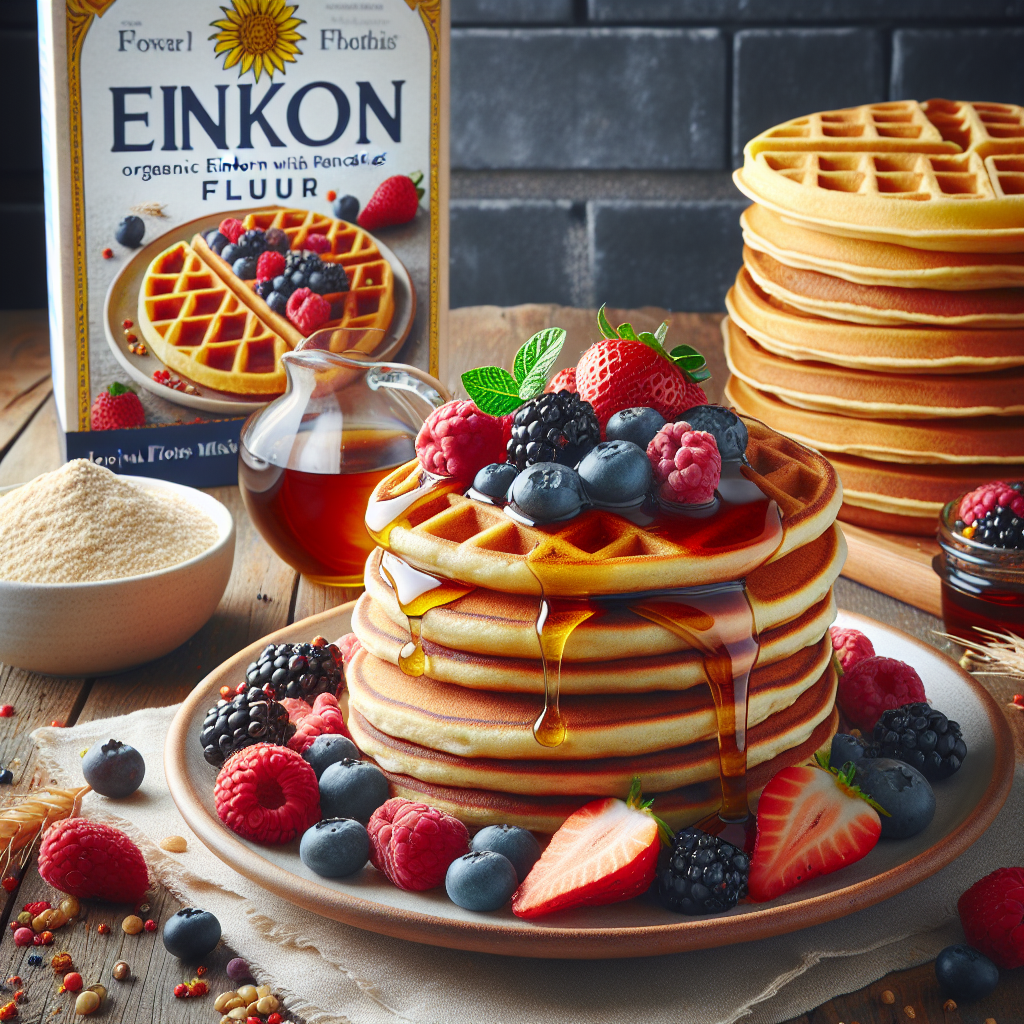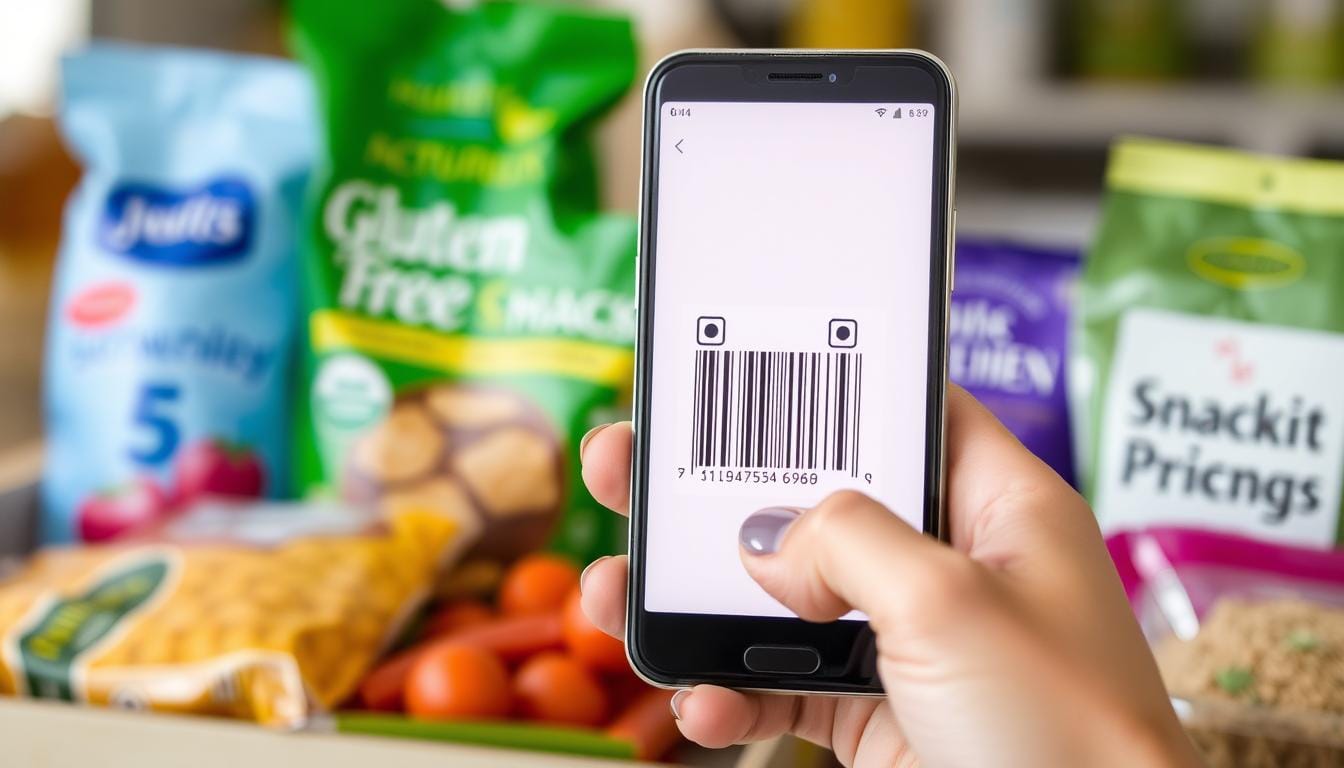Urgent recall issued for bread, cookies, and croutons due to life-threatening risk. Check if your products are affected and stay safe!
CN Traveller – CN Traveller
Discover the latest travel trends and expert tips from CN Traveller. Explore must-visit destinations for 2025 and elevate your next adventure!
FDA Announces Nationwide Recall on Popular Frozen Snack – AOL.com
FDA issues a nationwide recall on a popular frozen snack due to safety concerns. Discover which product is affected and how to stay safe.
Jovial Foods Organic Einkorn Pancake & Waffle Mix – Progressive Grocer
Discover Jovial Foods Organic Einkorn Pancake & Waffle Mix—ancient grains for wholesome, delicious breakfasts. Now featured in Progressive Grocer!
Why gluten-free foods are taking over grocery store shelves – Salem News
Discover why gluten-free foods dominate grocery shelves, their impact on health, and practical tips for managing gluten sensitivities and celiac disease effectively.
‘AITA for refusing to eat at a restaurant that served me gluten? My family thinks I’m overreacting.’ UPDATED – Someecards
Navigating Gluten Allergy Reactions In a viral forum post titled “AITA for refusing to eat at a restaurant that served me gluten? My family thinks I’m overreacting.” the author goes to a restaurant found with “gluten free near me” and describes a severe reaction after inadvertently ingesting gluten in what they thought was gluten free bread. This heated debate raises important questions about the seriousness of gluten allergy and the social stigma sufferers often face.Gluten allergy, though less common than celiac disease or non‐celiac gluten sensitivity, can trigger life‐threatening reactions when someone with true wheat allergy ingests even trace amounts. Misunderstandings about the condition often lead families and friends to label dietary restrictions as extreme.In this comprehensive guide, we’ll explore the medical facts about gluten allergy, its impact on daily life, and practical strategies—like using tools such as Food Scan Genius—to prevent accidental exposures. Let’s start by highlighting the main takeaways. Key Takeaways True gluten allergy (wheat allergy) is distinct from celiac disease and non‐celiac gluten sensitivity. Accidental gluten ingestion can cause anaphylaxis in wheat‐allergic individuals. Clear communication with restaurants and use of scanning tools like Food Scan Genius can minimize risks. Support groups and resources from CDC, FARE, and Mayo Clinic offer guidance. Ongoing research at institutions like NIH aims to improve diagnosis and management. Background: Understanding Gluten Allergy A gluten allergy—often referred to as wheat allergy—is an immune response to proteins found in wheat (gliadin, glutenin) and related grains. Unlike celiac disease, which is an autoimmune disorder triggered by gluten, a wheat allergy can provoke immediate hypersensitivity reactions. Key points about gluten allergy: Onset: Symptoms usually appear within minutes to hours after ingestion. Prevalence: Wheat allergy affects about 0.2%–1% of the population, often in childhood. Triggers: Wheat-based products—bread, pasta, processed sauces, and even hidden ingredients in sauces or seasonings. Symptoms: From hives and swelling to difficulty breathing and anaphylaxis. Social Reactions: The online debate cited in the original post highlights how sufferers often face misunderstanding from loved ones who equate it with dietary preference rather than life‐threatening risk. Comparisons: Condition Immune Pathway Onset Treatment Wheat Allergy (Gluten Allergy) IgE‐mediated Minutes–Hours Strict avoidance, epinephrine Celiac Disease Autoimmune (T‐cell) Days–Weeks Gluten‐free diet Non‐Celiac Gluten Sensitivity Unknown/Innate Hours–Days Gluten reduction Medical & Scientific Explanation of Gluten Allergy A true gluten allergy involves the production of immunoglobulin E (IgE) antibodies specific to wheat proteins. Upon exposure, these antibodies trigger mast cell degranulation, releasing histamine and other mediators. Pathophysiology When wheat proteins enter the bloodstream through the gut mucosa, they cross‐link IgE on sensitized mast cells and basophils. This process releases: Histamine—causes vasodilation, itching Leukotrienes—bronchoconstriction Cytokines—systemic inflammation Symptoms & Severity Reactions can range from mild (urticaria, gastrointestinal discomfort) to severe (anaphylaxis). According to the CDC, anaphylaxis requires immediate epinephrine administration. Diagnosis Clinical history and symptom diary Skin prick testing or serum‐specific IgE measurement Oral food challenge under medical supervision For more in‐depth information, see the Mayo Clinic’s overview of food allergy. Impact of Gluten Allergy on Daily Life Living with a gluten allergy extends far beyond skipping bread. It affects social events, travel, and even employment situations where meals are shared. Social & Psychological Effects Isolation at group meals or parties. Anxiety about cross‐contact in kitchens. Stigma from friends and family who misunderstand the severity. Economic Burden Higher grocery costs for allergen‐free products. Medical expenses—doctor visits, testing, epinephrine auto‐injectors. Potential lost wages due to allergic reactions or appointments. Case Example The Reddit user who posted their dilemma described feeling “gaslit” by family members who said, “It’s just a little bread.” In truth, even cross‐contact with wheat flours can trigger life‐threatening anaphylaxis in some. Practical Advice for Managing Gluten Allergy Effective gluten allergy management hinges on prevention, emergency preparedness, and education. 1. Strict Avoidance Read labels: Wheat, durum, semolina, farina, einkorn. Ask questions: Confirm with chefs about hidden sources. 2. Emergency Plan Carry epinephrine auto‐injectors at all times. Wear medical ID jewelry indicating wheat allergy. Inform travel companions and restaurant servers of the allergy. 3. Technology: Food Scan Genius Food Scan Genius is a mobile app and portable scanner that reads food labels and cross‐references wheat allergens in real time. Its features include: Barcode scanning for immediate ingredient alerts. Optical recognition for restaurant menus. Customizable allergen profiles for gluten allergy. This tool reduces the risk of accidental exposure by flagging hidden wheat derivatives. 4. Communication Strategies Use clear language: “I have a wheat (gluten) allergy that can cause anaphylaxis.” Bring translation cards if dining abroad. Offer to provide safe menu suggestions or ingredients. Related Food Allergy Research & Developments Researchers are exploring novel therapies and diagnostics to improve quality of life for those with gluten allergy. Oral Immunotherapy (OIT) Studies at the NIH are investigating gradual exposure to wheat proteins to build tolerance. Early results show promise for reducing reaction severity. Biologic Therapies Monoclonal antibodies targeting IgE (e.g., omalizumab) are under clinical trials to raise the threshold of reaction to accidental gluten exposures. Non‐Invasive Diagnostics Novel breath and blood tests aim to detect wheat‐specific immune markers without the need for oral food challenges. Outlook Advances in precision medicine hold the potential to transform how we diagnose and treat wheat allergy, making strict avoidance less burdensome in the future. Resources & Support CDC Food Allergy Information Mayo Clinic Food Allergy Guide Food Allergy Research & Education (FARE) Allergy & Anaphylaxis Australia Frequently Asked Questions What is the difference between gluten allergy and celiac disease? Gluten allergy (wheat allergy) is an IgE‐mediated response causing immediate reactions. Celiac disease is an autoimmune reaction requiring strict lifelong gluten avoidance due to intestinal damage. Can I outgrow a gluten (wheat) allergy? Some children outgrow wheat allergy by late childhood, but adults are less likely to do so. Regular testing by an allergist can track changes in sensitivity. Is non‐celiac gluten sensitivity the same as wheat allergy? No. Non‐celiac gluten sensitivity causes gastrointestinal symptoms without an IgE or autoimmune response. Wheat allergy involves an IgE‐mediated allergic reaction. How can I prevent cross‐contact at restaurants? Inform staff of your allergy,
10 Gluten-Free Celebs Share Their Favorite Snacks – Celebwell
Discover top gluten-free snacks favored by celebrities, expert tips for safe celiac-friendly treats, and how Food Scan Genius can simplify your snack choices.
Does Trader Joe’s Sell Gluten-Free Pizza? – The Takeout
Discover if Trader Joe’s gluten-free pizza fits your dietary needs with expert insights, practical tips, and the latest research for celiac and gluten-sensitive shoppers.
Food Allergy News: Top 10 Hidden Additives Lurking in Your Favorite Baked Goods – MSN
Uncovering Hidden Additives in Baked Goods: A Guide for Wheat Allergy Sufferers According to the MSN article Top 10 Hidden Additives Lurking in Your Favorite Baked Goods, many commercial breads, cakes, and pastries hide chemicals that can aggravate wheat allergies. From dough conditioners to preservatives, these hidden additives in baked goods often go unlisted under obscure names. For those with a wheat allergy, even trace amounts of certain processing aids can trigger reactions ranging from mild hives to anaphylaxis. This guide will help you identify, understand, and avoid the most common hidden additives so you can enjoy baked treats safely. Key Takeaways Many bakeries use dough conditioners and bleaching agents that carry hidden wheat proteins. Read labels for ingredients like “vital wheat gluten” and “datem,” both common allergens. Use tools like Food Scan Genius to quickly detect hidden allergens on-the-go. Consult authoritative sources (CDC, Mayo Clinic, FARE) for up‐to‐date guidance on wheat allergy management. Stay informed on regulatory changes and new labeling standards to protect your health. Background on Wheat Allergies and Additives Wheat allergy is an immune response to one or more wheat proteins, such as albumin, globulin, gliadin, and glutenin. Unlike celiac disease, which is an autoimmune reaction to gluten, wheat allergy can trigger immediate hypersensitivity reactions. Up to 0.4% of adults and 1% of children in the U.S. are affected, according to the CDC. Bakeries often add enzymes, emulsifiers, and preservatives to improve texture, extend shelf life, and speed up production. Unfortunately, many of these hidden additives in baked goods derive from wheat or are processed with wheat-based carriers. Common additives include: DATEM (Diacetyl tartaric acid ester of mono‐ and diglycerides) Azodicarbonamide (dough conditioner and bleaching agent) Enzymes (maltogenic amylase, fungal alpha‐amylase) Since processing aids can escape direct listing on labels, wheat allergy sufferers must learn to decode technical jargon. National allergy groups like FARE recommend always asking bakeries for full ingredient lists and cross-contact procedures. Medical and Scientific Insights into Common Additives Additives serve functional purposes but can pose risks to sensitive individuals. Comparison of Top 10 Hidden Additives in Baked Goods Additive Function Potential Allergy Impact Label Synonyms DATEM Emulsifier Wheat protein trace Diacetyl tartaric acid esters Azodicarbonamide Dough bleacher Respiratory sensitizer ADA Enzymes Dough conditioner Cross‐reactivity risk Maltogenic amylase, fungal alpha‐amylase Vital Wheat Gluten Protein fortifier Direct allergen Gluten flour Propionic Acid Mold inhibitor Skin irritation PA, calcium propionate Researchers at the NIH report that even enzyme fractions can contain residual wheat proteins. The Mayo Clinic notes that inhalation of azodicarbonamide dust in bakeries has caused occupational asthma, underscoring the need for vigilance. Impact on Individuals with Wheat Allergies Hidden additives in baked goods can elicit a range of symptoms: Mild: itching, hives, digestive upset Moderate: facial swelling, wheezing, vomiting Severe: anaphylaxis, difficulty breathing, drop in blood pressure Case studies reveal that exposure to trace DATEM or residual gluten in enzymes often triggers reactions in highly sensitive individuals. According to a 2020 publication in the Journal of Allergy and Clinical Immunology, up to 15% of school‐aged children with wheat allergy experienced unexpected flare-ups after consuming commercially prepared breads. Beyond physical symptoms, hidden additives can cause significant anxiety. Patients often report hypervigilance around labels and distress in social settings. Allergists recommend carrying an auto-injectable epinephrine device at all times and wearing medical identification. Practical Advice for Managing Wheat Allergies and Hidden Additives 1. Read labels carefully: Look for both common and technical names (see table above). 2. Ask questions: Inquire about processing aids and cross‐contact procedures at bakeries. 3. Use Food Scan Genius: This smartphone app scans ingredient lists and barcodes to flag hidden gluten or wheat‐derived additives in real time. 4. Carry emergency medication: Always have epinephrine and antihistamines on hand. 5. Bake at home: Control every ingredient by using certified gluten-free flours and allergens-free recipes. For shopping, consider these tips: Choose products labeled “100% wheat‐free” or “gluten‐free,” certified by recognized agencies. Favor small‐batch or artisan bakeries that disclose full ingredient lists. Use apps like Food Scan Genius to minimize label‐reading errors and speed up decision-making. Latest Research and Developments Scientific advances are improving allergen safety: Novel enzymatic treatments that remove gluten proteins from wheat flour are in clinical trials. Blockchain‐enabled supply chains promise greater label transparency by tracing each additive from source to shelf. FDA proposals may soon require explicit labeling of all processing aids, closing loopholes that hide allergens. Machine learning algorithms—like those in Food Scan Genius—are being enhanced to detect emerging additive synonyms. In 2022, the European Food Safety Authority published guidelines recommending stricter testing methods for enzyme preparations to quantify residual wheat proteins. These initiatives may be adopted globally, boosting safety for allergy sufferers. Resources and Support For more information and support, visit: CDC Food Allergy Food Allergy Research & Education (FARE) Mayo Clinic Wheat Allergy Frequently Asked Questions What are the most common hidden additives in baked goods? The top hidden additives include DATEM, azodicarbonamide, various enzymes, vital wheat gluten, and propionic acid. Each serves a functional role but may pose allergy risks. How can I identify hidden wheat proteins on a label? Look for terms like “gluten,” “wheat starch,” “wheat flour,” and synonyms listed in our comparison table. Apps like Food Scan Genius can streamline label scanning. Is “gluten‐free” labeling enough to protect me? Certified “gluten‐free” labels reduce risk but always verify that no cross‐contact or hidden processing aids are used. Contact manufacturers if in doubt. Can I bake allergen‐free bread at home? Yes. Use certified gluten‐free flours and avoid commercial additives. Follow trusted recipes and keep utensils separate from wheat‐containing items. How does Food Scan Genius help allergy sufferers? Food Scan Genius uses advanced OCR and a comprehensive additive database to instantly flag hidden allergens in labels, helping users make safer food choices. Conclusion Hidden additives in baked goods pose real risks for wheat allergy sufferers. By learning to decode ingredient lists, using tools like Food Scan Genius, and staying informed on labeling updates, you can enjoy bakery treats safely. Always carry emergency medication, ask detailed
Study: Kissing after a gluten-filled snack is safe for people with celiac disease – News-Medical
Is Kissing After a Gluten-Filled Snack Safe for People with Celiac Disease? According to a recent study reported by News-Medical, “kissing after a gluten-filled snack is safe for people with celiac disease.” This finding brings relief to couples navigating strict gluten-free lifestyles. People with celiac disease must avoid even trace amounts of gluten, which can trigger intestinal damage and uncomfortable symptoms. However, new evidence suggests that brief intimate contact such as kissing carries a negligible risk of gluten transfer. Key Takeaways The study indicates kissing after a gluten-filled snack does not deliver enough gluten to trigger celiac damage. Gluten transfer through saliva is minimal compared to other exposures like shared utensils. Maintaining general oral hygiene and using tools like Food Scan Genius can further reduce any remote risk. Consult authoritative sources like the CDC and Mayo Clinic for celiac guidance. Implement simple practices—brushing teeth, rinsing mouth, or waiting 30 minutes after eating gluten—to feel confident. Background: Understanding Celiac Disease and Gluten Exposure Celiac disease is an autoimmune disorder where ingestion of gluten—a protein in wheat, barley, and rye—leads to inflammation and damage in the small intestine. According to the Celiac Disease Foundation (FARE), approximately 1% of the global population is affected. Strict avoidance of gluten is the only current treatment. Even tiny amounts (20 parts per million) can provoke symptoms such as bloating, diarrhea, and fatigue. That level has driven questions around non-dietary exposures like kissing after a gluten-filled snack. People often worry about cross-contact when using shared utensils or cooking surfaces. But saliva-mediated transfer has been underexplored until now. The recent study adds clarity: residual crumbs in the mouth are largely diluted and neutralized by saliva enzymes. Still, those with celiac disease remain cautious. Many ask: Is it safe to share a quick kiss after eating bread or cookies? The study’s answer: The risk is orders of magnitude lower than common culinary cross-contaminations. Medical and Scientific Explanation The research measured gluten levels in saliva after subjects consumed a high-gluten meal (~5 grams). Saliva samples were collected immediately, then at 15, 30, and 60 minutes. Analysis used enzyme-linked immunosorbent assay (ELISA) tests sensitive to 5 ppm of gluten. Key findings: Immediate sample: 1–3 ppm gluten detected. After 15 minutes: <0.5 ppm detected (below threshold for reaction). After 30 minutes: no detectable gluten. Given that the threshold to trigger celiac symptoms is ~20 ppm, the study concluded that kissing even within 15 minutes poses minimal risk. Researchers attribute this to: Salivary amylase breaking down gluten protein. Dilution effect in oral fluids. Limited volume exchanged in a typical kiss. For peer-reviewed context, see the National Institutes of Health (NIH) database on gluten immunogenicity. This study aligns with existing literature showing indirect gluten transfer (shared cups, utensils) is more concerning. Comparison of Gluten Exposure Routes Exposure Route Approx. Gluten Level Risk Classification Eating gluten-containing food >1000 ppm High Kissing after a gluten-filled snack 1–3 ppm initially; <0.5 ppm after 15 mins Low Shared utensils or straws 10–50 ppm Moderate Impact on Individuals with Celiac Disease For those living gluten-free, emotional and social factors matter. Food often plays a central role in dating and relationships. Anxiety about accidental gluten exposure can strain intimacy. This new data can alleviate some fears: kissing is a natural expression of affection that need not be avoided. Experts note the psychological benefit of reduced anxiety around close contact. However, reactions vary. A small subset of highly sensitive individuals may prefer additional safeguards. Open communication between partners is key. Discuss personal comfort levels and decide on simple hygiene practices together. Overall, knowing that kissing after a gluten-filled snack is safe helps people with celiac disease enjoy more relaxed social interactions without compromising health. Practical Advice for Managing Gluten Risks Even with low-risk exposures, adopting basic habits enhances safety and peace of mind. Wait 15–30 minutes after eating gluten before kissing. Brush teeth or rinse mouth thoroughly. Keep a pack of sugar-free gum or mouthwash handy. Try Food Scan Genius—a handheld device that analyzes food and saliva traces for gluten, helping determine safe timing for intimate contact. Educate partners on cross-contact prevention in the kitchen. By combining these steps, couples can foster both safety and intimacy. Related Food Allergy Research and Developments Beyond celiac disease, researchers explore similar questions in other allergies: Peanut protein transfer via saliva—showing negligible allergic activation in controlled kissing studies. Latex allergies and intimate contact—investigating skin-to-skin antigen transfer. New wearable sensors monitor environmental allergen levels in real time. Advances in immunotherapy aim to desensitize patients to trace allergen exposures. For ongoing updates, follow the NIH and the Celiac Disease Foundation. Resources and Support Options CDC on Celiac Disease Mayo Clinic Overview Celiac Disease Foundation (FARE) Gluten Intolerance Group Frequently Asked Questions Can kissing really transfer gluten? Yes, but only trace amounts (<3 ppm) immediately after a gluten-filled snack—well below the threshold to trigger celiac symptoms. How long should I wait after eating gluten to kiss? Waiting 15–30 minutes, plus rinsing or brushing, virtually eliminates detectable gluten in saliva. What is Food Scan Genius? Food Scan Genius is a portable gluten-detection device that analyzes food particles and saliva traces, helping users gauge if it’s safe to kiss. Are there other indirect gluten exposures to worry about? Shared utensils, cutting boards, or straws can pose moderate risk; always clean or use separate items. Conclusion Emerging evidence shows that kissing after a gluten-filled snack carries a very low risk for people with celiac disease. Simple steps—waiting, rinsing, and using tools like Food Scan Genius—ensure both safety and spontaneity. Embrace intimacy without fear and keep enjoying the moments that matter.














